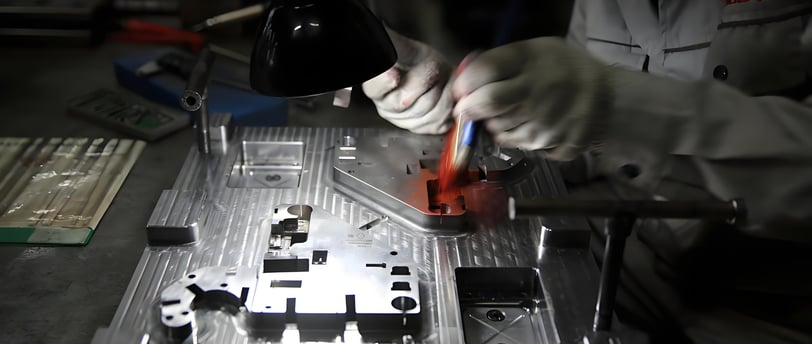Introduction to the Application of Stamping Molds in the Medical Industry
2/19/2025


Understanding Stamping Molds
Stamping molds are specialized tools utilized in the manufacturing process to shape and form materials, primarily metal, into specific parts and components. They play a critical role in various industries, including the medical sector, where precision and reliability are paramount. A stamping mold consists of several key components, including the die, which defines the shape of the final product, and the punch, which exerts the force necessary to stamp the material into the desired form.
There are several types of stamping molds that manufacturers may employ, each designed to meet particular product specifications. These include progressive dies, which allow for multiple operations in a single pass, and transfer dies, where the stamped part is moved between stations for further shaping. Additionally, deep draw dies are used for creating parts with deeper shapes, while compound dies can perform several operations simultaneously. The choice of stamping mold type often depends on factors such as production volume, material properties, and the complexity of the part being produced.
The materials used to fabricate stamping molds are crucial to their functionality and longevity. Common materials include high-carbon steel and tool steel, which offer excellent durability and wear resistance. Manufacturers must consider various factors when selecting materials, including the expected number of stampings, the type of material being stamped, and the desired surface finish. Proper design and material selection ensure that stamping molds can withstand repeated use while maintaining the precision required for medical applications, where even minor variations can lead to significant issues. Understanding the foundational principles of stamping molds is essential for professionals involved in the design and manufacturing of medical devices and components.
Role of Stamping Molds in Medical Device Manufacturing
Stamping molds serve an integral purpose in the manufacturing of medical devices, facilitating the production of various components with exceptional precision. Medical devices such as surgical instruments, diagnostic equipment, and implants heavily rely on stamping molds to ensure that parts are manufactured accurately and consistently. The use of stamping molds in the medical industry allows for high-volume production while maintaining the stringent quality standards required in this sector.
In the realm of surgical instruments, stamping molds are employed to create blades, handles, and specialized tools crucial for operations. The importance of precision cannot be overstated, as even slight inaccuracies can lead to significant complications in surgical procedures. The ability to reproduce components with exact dimensions using stamping molds is essential for the safety and effectiveness of surgical interventions.
The role of stamping molds extends beyond surgical tools to include diagnostic equipment. In tools such as blood analyzers and imaging devices, stamping molds allow for the production of parts that have intricate designs and tight tolerances. This is critical, as the efficacy of diagnostic devices is often contingent on the accuracy of their components. Furthermore, the consistent quality provided by stamping molds helps manufacturers comply with regulatory standards that govern medical device production.
Implants, another crucial area in which stamping molds are utilized, require components that meet high standards of durability and biocompatibility. The precision achieved through this manufacturing technique ensures that implants fit correctly and function optimally within the human body. By employing stamping molds, manufacturers can produce implants at scale without sacrificing quality, thereby ensuring accessibility for patients.
Ultimately, the role of stamping molds in medical device manufacturing cannot be overlooked. Their contribution to precision, efficiency, and quality control reinforces the necessity of adhering to rigorous industry standards that protect patient safety and enhance medical outcomes.
Advantages of Using Stamping Molds in the Medical Sector
The utilization of stamping molds in the medical sector presents a myriad of advantages that significantly enhance manufacturing processes. One of the primary benefits is cost-effectiveness. Stamping molds are designed for high-volume production, which drastically reduces the per-unit cost of medical components. This is particularly advantageous for medical devices that need to be both affordable and available in large quantities to meet market demands.
Efficiency in mass production is another critical advantage. Stamping molds are capable of producing thousands of identical parts in a short timeframe, ensuring consistency and reliability in product quality. The automation involved in the stamping process minimizes manual labor and reduces human error, leading to a more streamlined production line. As a result, medical manufacturers can maintain high output rates without compromising on the quality needed for life-saving devices.
Moreover, stamping molds allow for the creation of complex shapes with precision. This capability is essential in the medical field where components often require intricate geometries and specifications. Unlike traditional manufacturing methods that might struggle with such complexities, stamping can produce detailed designs uniformly, maintaining stringent tolerances essential for medical applications.
Innovation and design flexibility are additional benefits associated with the use of stamping molds. The adaptability of stamping technology enables manufacturers to quickly transition to new designs, accommodating the evolving requirements in the medical industry. For instance, as medical technology advances, the ability to readily alter designs without significant downtime is invaluable, fostering continuous improvement and adaptation within the sector.
Incorporating stamping molds ultimately enhances the ability of medical manufacturers to deliver reliable, cost-effective, and innovative products that address contemporary healthcare challenges.
Future Trends and Innovations in Stamping Mold Technology for Medicine
The medical industry is experiencing a transformation, largely driven by advancements in stamping mold technology. As demand for precision and efficiency grows, serialization, automation, and innovative manufacturing techniques are reshaping how medical devices are produced. One of the most significant trends is the integration of advanced automation systems into the stamping process. Automation not only enhances productivity but also reduces human error, leading to improved quality control of medical components. Manufacturers are increasingly adopting robotic systems and smart technologies that streamline production workflows, enabling faster turnaround times while maintaining high standards of accuracy.
Another promising innovation in the field is the use of 3D printing. This technology allows for rapid prototyping and the ability to create complex geometries that traditional stamping methods may not achieve. By combining 3D printing with stamping molds, manufacturers can develop intricate designs tailored to specific medical applications. This not only helps in reducing material waste but also lowers production costs, as custom molds can be produced more efficiently. Furthermore, advancements in materials science are playing a pivotal role. New materials that exhibit higher strength with lower weight are becoming available, which can enhance the functionality and longevity of medical devices produced through stamping.
However, the evolution of stamping molds in the medical sector does not come without challenges. As manufacturers adopt these new technologies, they will need to invest in training and development to ensure their workforce is equipped with the necessary skills. Additionally, the integration of new technologies may necessitate reevaluation of traditional compliance and regulatory standards. Companies must navigate these complexities to harness the full potential of innovations in stamping mold technology. The future holds the promise of enhanced productivity, quality, and sustainability in the manufacturing of medical devices, paving the way for more effective healthcare solutions.
